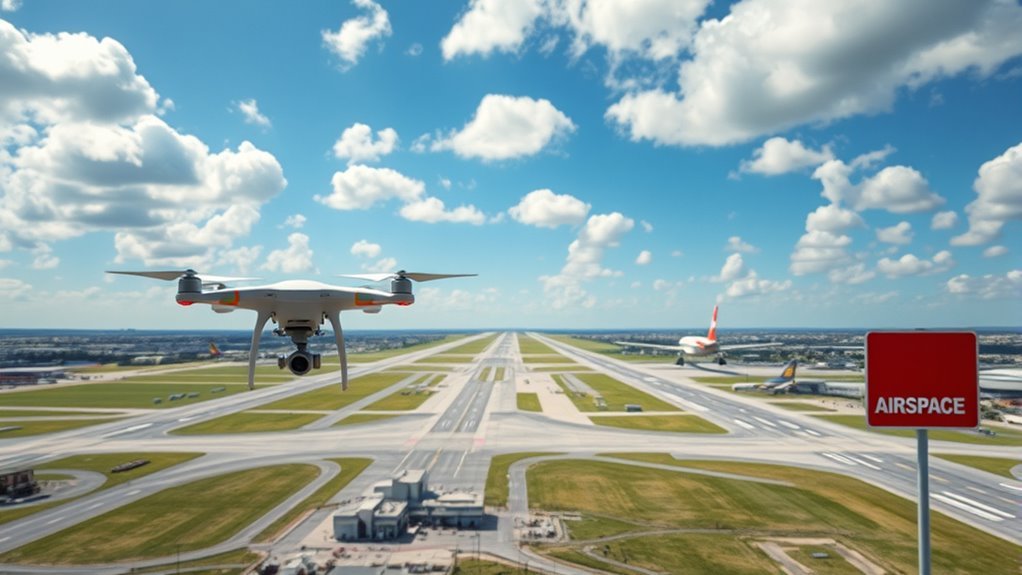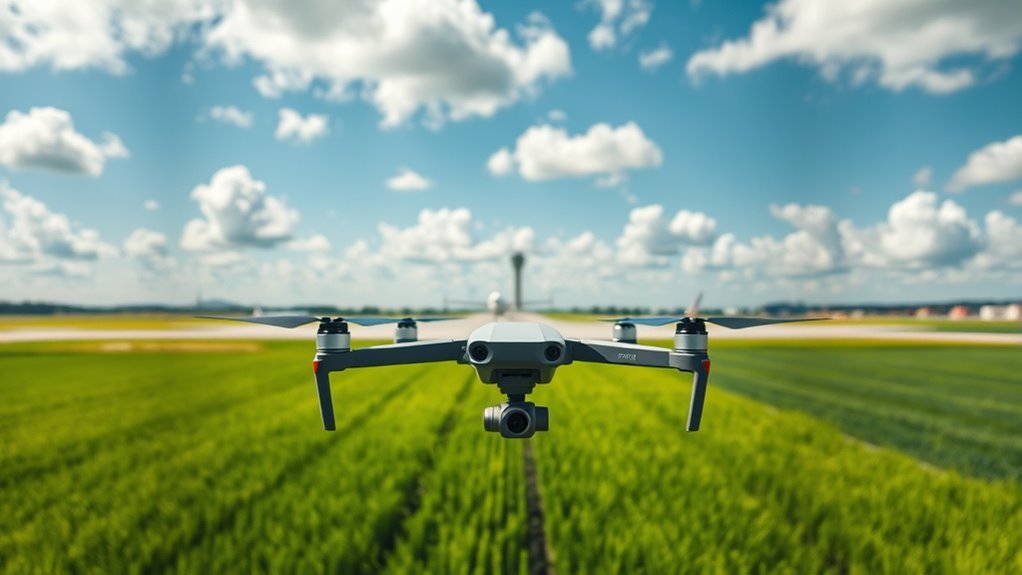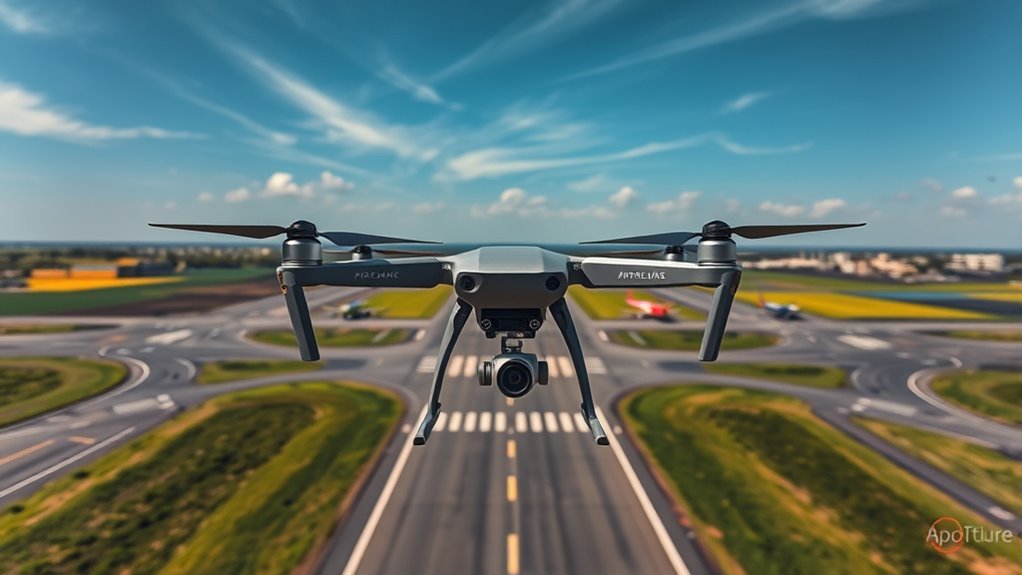You can’t fly your drone within five miles of an airport without notifying the control tower first. This FAA regulation is essential for preventing potential collisions with manned aircraft. Whether you’re flying recreationally or commercially, it’s vital to comply with these rules to avoid hefty fines or legal trouble. Remember, there are different regulations for various types of airports, which you should understand. There’s more to know about safe drone operation near airports, so keep going.
Understanding Controlled Airspace

When you’re planning to fly your drone near an airport, it’s crucial to understand controlled airspace, as it’s specifically designed to manage aircraft movements and guarantee safety. Controlled airspace layers are categorized into various airspace classifications, such as Class B, C, D, and E. Each classification has specific rules governing drone operations, including altitude restrictions and communication requirements. For instance, Class B airspace typically surrounds major airports and requires permission before flying. Recognizing these classifications helps you navigate the complexities of controlled airspace while pursuing your passion for flying. Remember, understanding these regulations not only keeps you compliant but also enhances safety for both manned and unmanned aircraft. Always check the airspace status before launching your drone.
The 5-Mile Rule Explained

When flying your drone near an airport, it’s essential to understand the 5-mile rule set by the FAA. This regulation restricts drone operations within five miles of an airport without prior notification to the facility, ensuring safety for both pilots and air traffic. Familiarizing yourself with these guidelines will help you avoid potential legal issues and enhance overall safety in the airspace.
FAA Regulations Overview
Although you may be enthusiastic to capture stunning aerial footage, it’s vital to understand the FAA regulations governing drone operation near airports. The FAA enforces a 5-mile rule, meaning you can’t fly your drone within five miles of an airport without prior authorization. This rule applies to all drone classifications, including recreational and commercial operators. The reason behind this regulation is to guarantee safe air traffic management and prevent potential collisions with manned aircraft. If you’re within this zone, it’s important to notify the airport or seek permission through the FAA’s LAANC system. Respecting these regulations not only keeps you compliant but also contributes to safer skies for everyone. Stay informed and fly responsibly to enjoy the freedom of aerial exploration.
Safety Considerations Explained
Understanding the 5-mile rule is essential for drone operators, as this regulation greatly impacts where you can legally fly. To guarantee safety and compliance, consider these key points during your risk assessment and flight planning:
- Distance Matters: Always maintain a minimum 5-mile distance from airports unless authorized by air traffic control.
- Know Your Airspace: Familiarize yourself with the types of airspace around airports, as some may have additional restrictions.
- Emergency Protocols: Have a plan in place for emergencies, including immediate landing zones and communication with nearby air traffic.
Types of Airports and Their Regulations

When flying your drone near airports, it’s essential to understand the different regulations that apply to commercial airports and private airfields. Commercial airports have stricter guidelines due to higher traffic and safety concerns, while private airfields may have more lenient rules, but still require caution. Familiarizing yourself with these regulations will help you avoid legal issues and guarantee safe operations.
Commercial Airports Regulations
As you navigate the complexities of drone regulations near commercial airports, it’s essential to recognize that these facilities are subject to specific rules designed to secure safety and security. You must adhere to airport proximity restrictions to guarantee safe commercial drone usage. Here are three key regulations you should keep in mind:
- No Fly Zones: Generally, you can’t operate your drone within a five-mile radius of a commercial airport without permission.
- Notification Requirements: Always notify the airport control tower if you plan to fly within regulated airspace.
- Altitude Limits: Maintain your drone below 400 feet to reduce the risk of interfering with manned aircraft.
Understanding these regulations empowers you to enjoy your drone flying while securing safety for all in the airspace.
Private Airfields Guidelines
While commercial airports have strict regulations, private airfields present a different set of guidelines for drone operators. At private airfields, you typically have more leeway in your drone operations, but it’s essential to respect the property owner’s rules and local regulations. Always get permission from the airfield owner before flying; they may have specific hours or operational limits. You should also check if the airfield is registered with the FAA, as this can influence your ability to fly nearby. Finally, maintain a safe distance from manned aircraft and be aware of any ongoing flight activities. By following these guidelines, you can enjoy the freedom of flying your drone while ensuring safety and compliance at private airfields.
Consequences of Violating Drone Flight Rules
Violating drone flight rules, especially near airports, can lead to serious consequences that affect both safety and legal standing. If you decide to ignore these regulations, you might face the following repercussions:
- Legal Penalties: You could incur hefty fines or even criminal charges, depending on the severity of the violation.
- Drone Confiscation: Authorities can seize your drone, leaving you without your equipment and investment.
- Increased Scrutiny: Your flying privileges might be revoked, resulting in heightened oversight of your future flights.
Understanding these consequences helps you appreciate the importance of compliance. While the freedom to fly is enticing, respecting airspace rules guarantees your safety and the safety of others. Don’t risk it—fly responsibly.
Tools and Resources for Safe Flying
How can you guarantee a safe flying experience with your drone? Utilizing the right tools and resources is essential for effective flight planning and drone mapping. Here are some resources you should consider:
| Tool/Resource | Purpose |
|---|---|
| FAA Drone Zone | Check airspace restrictions |
| UAV Forecast | Weather conditions assessment |
| Airmap | Flight planning assistance |
| SkyVector | Aeronautical charts access |
| DroneDeploy | Efficient drone mapping |
Additionally, it’s important to be aware of federal regulations that govern drone operations near airports to ensure compliance while flying. Understanding airspace limits is crucial to avoid legal repercussions during your flights.
Tips for Responsible Drone Operation Near Airports
When operating your drone near an airport, it is crucial to understand and respect the regulations that govern airspace to guarantee safety for both manned and unmanned aircraft. Practicing good drone etiquette and effective airport communication can help facilitate a smooth flying experience. Here are some tips to follow:
- Check Airspace Regulations: Always verify the airspace classification around the airport and adhere to height restrictions.
- Notify Airport Authorities: If you’re flying within five miles of an airport, notify the local control tower to maintain awareness of your drone’s presence.
- Maintain Visual Line of Sight: Keep your drone within your view at all times to prevent accidental incursions into restricted airspace. Additionally, ensure compliance with local regulations to avoid legal issues and promote safe drone operations.
Frequently Asked Questions
Can I Fly My Drone at Night Near an Airport?
You can’t fly your drone at night near an airport without adhering to night flying regulations and airport proximity guidelines. Make certain you’re aware of these rules to avoid fines and guarantee safe operations.
What Are the Penalties for Flying Too Close to an Airport?
Imagine soaring like a bird, but if you fly too close to an airport, you risk hefty fines and serious violations. Be aware of the legal implications; freedom comes with responsibility, so know the rules.
Do All Drones Require Registration Before Flying Near Airports?
Yes, most drones require registration before flying, especially near airports. Familiarizing yourself with drone registration and airport regulations is essential to guarantee compliance and maintain your freedom to fly without facing penalties or restrictions.
Can I Fly My Drone if I Have a Remote Pilot Certificate?
Having a remote pilot certificate allows you to fly your drone, but you must prioritize drone safety and adhere to pilot responsibilities. Always stay informed about regulations to guarantee a safe and responsible flying experience.
Are There Any Exceptions for Emergency Drone Flights Near Airports?
In life’s unpredictable storm, you might find yourself needing to navigate emergency landings. While regulations often restrict drone flights near airports, exceptions exist to protect public safety, allowing you to respond swiftly when it truly matters.

